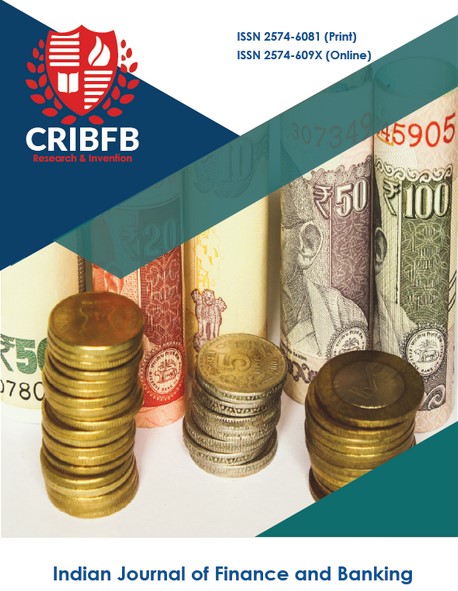VALUE DRIVERS OF BANK EQUITY MARKET PRICE
Main Article Content
Abstract
The Indian banking sector has shown robustness and resilience in the face of challenges on account of rising non-performing assets and economic upheavals. The market value of bank equity is a reflection of the financial performance of banks and macroeconomic factors. 22 bank-specific variables and 5 macroeconomic factors representing profit management, capital management, shareholder value management and risk and leverage management, India’s Real GDP Growth Rates (Factor Cost), Money Supply growth, Bank Credit growth, Deposit growth rate and Inflation are used in this study. 19440 observations are examined from the financial data of 40 commercial banks (private and public sector banks for a period of eighteen years. The data is analyzed using panel regression. Hausman and Pagan's test was conducted to find the best-fit model. The results show that Finance Charge Coverage (FCCR), Advance Loan funds, Current Ratio, Beta and Asset Turnover have a negative impact on bank equity value and Activity Mix, Revenue Efficiency, Earnings Retention, and Cost Management shows a positive significant relationship with equity value. Factors like FCCR affects the market values of public sector banks and private sector banks differently Growth in GDP, Inflation shows a positive relationship with the market value of bank equity. Growth in Money Supply has a differential impact on the market value of private sector banks and public sector banks. The results provide useful insights to understand the determinants of the market value of bank equity. It can help bankers frame strategies to maintain and enhance the market value of their equity.
JEL Classification Codes: E52, E58, M41.
Downloads
Article Details
Section
How to Cite
References
Baele, L., De Jonghe, O., & Vander Vennet, R. (2007). Does the stock market value bank diversification?. Journal of Banking & Finance, 31(7), 1999-2023.
Copeland Thomas, E., Koller, T., & Murrin, J. (1994). Valuation: Measuring and Managing the Value of Companies, 3rd edition. New York.
Dayal, R., Luther, L. U., Neu, P., & Yang, T. (2010). After the Storm-Creating Value in Banking 2010. Boston Consulting Group, Boston, Feb.
Das, A., Nag, A., & Ray, S. C. (2005). Liberalisation, ownership and efficiency in Indian banking: a nonparametric analysis. Economic and political weekly, 1190-1197.
Fiordelisi, F., & Molyneux, P. (2007, February). Value creation in banking. In EFA 2007 Ljubljana Meetings paper.
Gross, S. (2007). Banks and shareholder value: An overview of bank valuation and empirical evidence on shareholder value for banks.
Jadhav, N., & Ajit, D. (1996). The Role of Banks in the Economic Development of India, Prajnan, 25(3–4), 309–409.
Koller, T., Goedhart, M., & Wessels, D. (2010). Valuation: measuring and managing the value of companies (Vol. 499). john Wiley and sons.
Kumbhakar, S. C., & Sarkar, S. (2003). Deregulation, ownership, and productivity growth in the banking industry: evidence from India. Journal of Money, Credit and banking, 403-424.
Mohan, T. R. (2008). Is It Time to Open Up to Foreign Banks?. Economic and Political Weekly, 12-14.
Mahesh, H. P., & Bhide, S. (2008). Do financial sector reforms make commercial banks more efficient? A parametric exploration of the Indian case. Margin: The Journal of Applied Economic Research, 2(4), 415-441.
Rangarajan, C., & Mampilly, P. (1972). Economies of scale in Indian banking. Technical studies for banking commission report, Reserve Bank of India, Mumbai, 244-268.
Rajan, S. S., Reddy, K. L. N., & Pandit, V. N. (2011). Efficiency and Productivity Growth in Indian Banking. Centre for Development Economics, Department of Economics, Delhi School of Economics (No. 199). Working Paper.
Rappaport, A. (1999). Creating shareholder value: a guide for managers and investors. Simon and Schuster.
Sengupta, J., & Thomas, R. (2007). Mckiney & Company Report on “Indian Banking : Towards Global Bank practices insights from industry benchmarking survey” , working assigned by Indian Banking Association.
Subrahmanyam, G., & Swami, S. B. (1993). Bilateral Productivity Comparisons of Public Sector Banks in India. The Indian Economic Journal, 41(1), 1-17.
Shanmugam, K. R., & Das, A. (2004). Efficiency of Indian commercial banks during the reform period. Applied Financial Economics, 14(9), 681-686.
Sensarma, R. (2005). Cost and profit efficiency of Indian banks during 1986-2003: a stochastic frontier analysis. Economic and Political Weekly, 1198-1209.
Tyagarajan, M. (1975). Impact of Expansion on Banks' Earnings, Expenses and Profits. Economic and Political Weekly, 1841-1847.
Visalli, S., Roxburgh, C., Daruvala, T., Dietz, M., Lund, S., & Marrs, A. (2011). The state of global banking–in search of a sustainable model. McKinsey Annual Review on the Banking Industry (New York).




